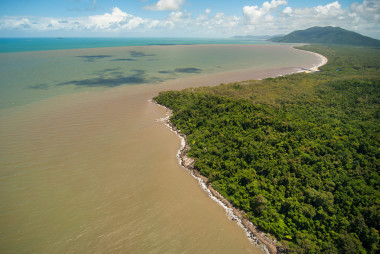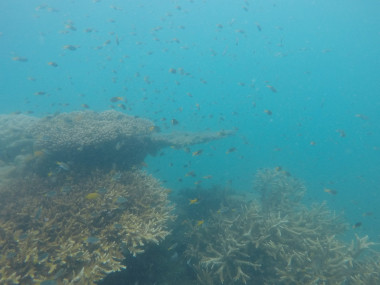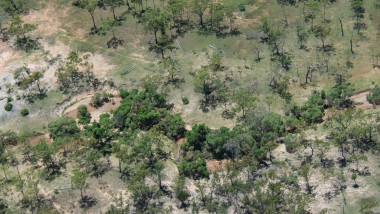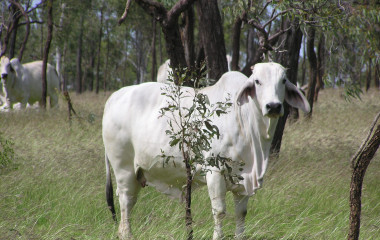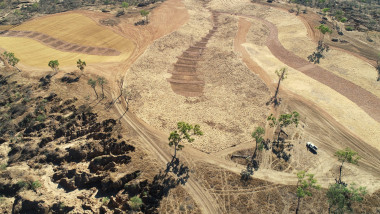Fine sediment inputs to the Great Barrier Reef can cause important ecological impacts such as reduction in benthic light, smothering of benthic organisms, direct disturbance by suspended particles or increased loads of particulate and potentially bioavailable nutrients. Across the Great Barrier Reef, a 25% reduction in the 2009 anthropogenic end-of-catchment fine sediment loads, and a 20% reduction of particulate nutrients, is required to meet the 2025 targets defined in the Reef 2050 Water Quality Improvement Plan. Substantial effort is required to meet these targets, especially in the basins delivering the largest fine sediment and particulate nutrient loads to the Great Barrier Reef, and particularly in the context of other stressors including climate change.
Scope
The diagram below shows the scope of the sediments and particulate nutrients theme. It represents the Great Barrier Reef catchment and marine environment and shows the ecological impacts of fine sediment and particulate nutrients on aquatic ecosystems and biota including the influence of flood plumes which mostly affect inshore and midshelf areas. The primary sources are shown, of which grazing is the largest contributor, followed by cropping and other land uses, along with the transport pathways for fine sediments and particulate nutrients from the catchment to the Great Barrier Reef. Transport is heavily driven by vegetation degradation and surface disturbance which contribute to accelerated hillslope, gully and streambank erosion. Examples of potential management measures to minimise runoff are illustrated including the need to maintain ground cover and riparian vegetation, and gully and streambank restoration. Climate change is also identified as affecting the frequency and severity of droughts and floods, both of which are likely to exacerbate vegetation degradation, surface disturbance and soil degradation.
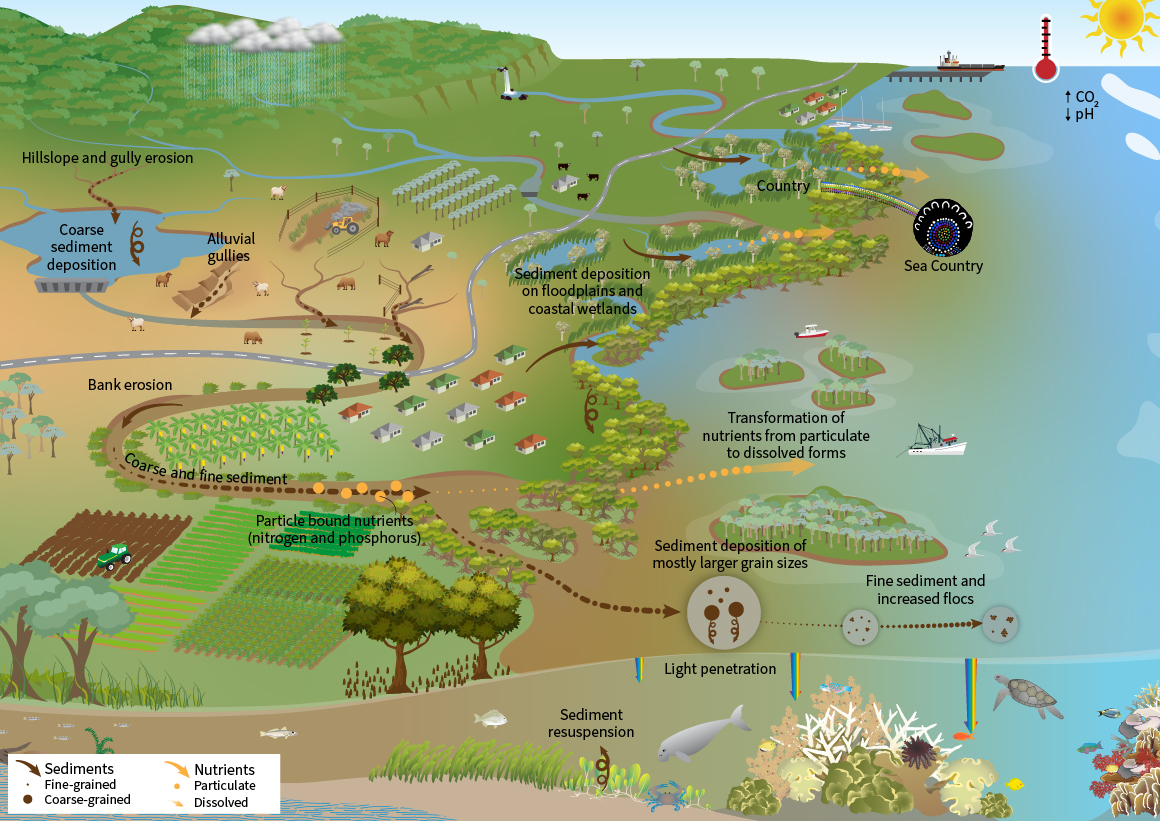
Context
Fine sediment inputs to the Great Barrier Reef can cause important ecological impacts such as reduction in benthic light, smothering of benthic organisms, direct disturbance by suspended particles or increased loads of particulate and potentially bioavailable nutrients. Across the Great Barrier Reef, a 25% reduction in the 2009 anthropogenic end-of-catchment fine sediment loads, and a 20% reduction of particulate nutrients, is required to meet the 2025 targets defined in the Reef 2050 Water Quality Improvement Plan. Substantial effort is required to meet these targets, especially in the basins delivering the largest fine sediment and particulate nutrient loads to the Great Barrier Reef, and particularly in the context of other stressors including climate change.
The synthesis of the evidence for sediments and particulate nutrients included a total of 850 studies extracted and synthesised for 6 questions (with some overlap in evidence between questions). This theme reviews the evidence of the causal relationships between the impacts, sources and management of sediments and particulate nutrients influencing the Great Barrier Reef. It starts with the evidence of the ecological processes within the Great Barrier Reef including the spatial and temporal distributions of terrigenous sediments and associated indicators (Q3.1), and the measured impacts of those sediments and particulate nutrient loads on Great Barrier Reef ecosystems (Q3.2). The primary sources are presented (Q3.3), with expansion of the evidence of the biophysical drivers, transport and delivery processes of fine sediment and particulate nutrient export from the catchment area to the Great Barrier Reef (Q3.4). Synthesis of the most effective management practices for reducing sediment and particulate nutrient export from the Great Barrier Reef catchment area provides insights for policy and management (Q3.5), with specific review of the effectiveness of gully remediation and streambank rehabilitation actions (Q3.6).
Summary statement for Sediments and particulate nutrients
The synthesis of the evidence for sediments and particulate nutrients included a total of 850 studies extracted and synthesised for 6 questions (with some overlap in evidence between questions). The Summary Statement was developed using the evidence base from the six questions in this theme. Convergence was reached for this Summary Statement among all authors within the Expert Group for this theme.
The summary of findings relevant to policy or management action for sediments and particulate nutrients are:
- The export of sediments and particulate nutrients to the Great Barrier Reef have increased for most river basins over the last 170 years since the arrival of Europeans. There are distinct patterns of sediment composition across the continental shelf of the Great Barrier Reef. The inner shelf (up to 20 metres water depth) is dominated by land-derived ‘terrigenous’ sediment shifting to predominantly marine sediment derived from corals, shells and other carbonates, in the outer shelf (>40 metres depth). In situ monitoring and remote sensing data show a clear spatial gradient of decreasing turbidity levels with increasing distance from river mouths, likely related to the depth of the water column (i.e., degree of wave resuspension) and the availability of sediment on the seafloor to be readily resuspended. [Q3.1]
- While most sediment-laden flood plumes are confined to the inner shelf of the Great Barrier Reef, at times during periods of large riverine discharge and low wind speeds, fine (<20 µm) terrigenous sediment and associated particulates can be carried to the middle shelf and even the outer shelf (particularly for the areas northwards of Bowen where the middle and outer shelf is closer to the coast). Reduced water quality can persist for up to six months due to frequent resuspension of this newly delivered sediment following large discharge events. Increases in sediment loads since the arrival of Europeans greatly influences the area of the inner and middle shelf affected by diminished light. Studies on particulate nutrients in flood plumes and river estuaries highlight the potential for rapid transformation of particulate nutrients to bioavailable forms (dissolved nutrient forms that are readily consumed by algae) within coastal areas. [Q3.1]
- Increases in the loads of fine sediments and particulate nutrients affect the quantity and quality of light (i.e., modified light spectrum towards ‘less usable’ light) reaching coral reefs, seagrass and other benthic organisms and can influence the behaviour and condition of animals including fish, particularly in inshore areas. This has resulted in persistent impacts on reef composition (including changes in the abundance and diversity of species at different depths, and increases in macroalgal growth), and variability in the distribution, abundance and composition of seagrass meadows. These direct effects can result in indirect effects on other taxa including seagrass-dependent dugong which can extend across the whole Great Barrier Reef. The greatest impacts of fine sediments and particulate nutrients occur in the inshore central and southern Great Barrier Reef (Wet Tropics to Burnett Mary Natural Resource Management regions). [Q3.2]
- Sedimentation, the settling of sediments and particulate nutrients onto surfaces, can also have negative direct effects on a variety of taxa including corals, causing tissue damage, reducing growth rates and altering microbial communities. Importantly, settled and suspended particulate matter can suppress recovery from other disturbance events (e.g., heatwaves, cyclones) and affect recruitment and early life stages of corals and fishes. [Q3.2]
- Overall, exports of anthropogenic fine sediment to the Great Barrier Reef are estimated to be 1.4 to 5 times higher than pre-development loads (depending on the basin). These estimates are supported by a range of evidence including modelling, geochemical and isotope tracing of the sources of exported material, and proxy records of exports over time in sediments and coral cores. The Burdekin and Fitzroy basins are the largest exporters of total fine sediment and particulate nutrients to the Great Barrier Reef (including anthropogenic exports), each exporting an annual average load of over 3,000 kilotonnes and 1,300 kilotonnes of fine sediment per year, respectively, and more than 3,000 tonnes of particulate nitrogen per year. [Q3.3]
- Grazing land use is the largest contributor of fine sediment export to the Great Barrier Reef (especially in the Burdekin and Fitzroy regions), estimated to generate 60% of the total export and a larger proportion of the anthropogenic export, with all other land uses each contributing much smaller amounts. Intense land uses such as mining and developing urban areas can generate large sources of fine sediment locally but cover a relatively small area and overall exports are relatively small. It is estimated that gully erosion contributes around 50% of the total fine sediment load exported from the Great Barrier Reef catchment area, with the remainder comprised of almost equal contributions from streambank erosion and hillslope erosion. Each process can dominate in particular basins. [Q3.3]
- The most important primary biophysical drivers of anthropogenic sediment and particulate nutrient exports to the Great Barrier Reef include vegetation degradation (e.g., land/tree clearing, low ground cover, and changes in structure and function of grass species including a shift to non-native pastures, typically in response to long-term grazing pressure), surface disturbance from cattle trampling, feral animals, tillage in cropping areas, historical surface mining, unsealed roads and construction earthworks. While these drivers vary between erosion types, in different locations and at different times, gully erosion is strongly driven by surface disturbance and vegetation degradation / low ground cover, and streambank erosion is accelerated by removal or degradation of riparian vegetation and grazing pressure. Soil degradation, spatial concentration of runoff by roads, tracks and fence lines are also important drivers in some locations. Runoff detention by large dams has reduced exports significantly but have been outweighed severalfold by the other drivers, and dams are less effective at trapping fine-grained sediments of most ecological risk to downstream Great Barrier Reef ecosystems. [Q3.4]
- The Reef Water Quality Report Card 2020 estimated that ’Moderate’ overall progress has been made towards meeting the Reef 2050 Water Quality Improvement Plan fine sediment load reduction target and ‘Very Good’ progress for the particulate nutrient load reduction targets. In some basins, targets are assumed to have been met (including several basins in the Cape York region) while in others, especially those that were not given management priority, there has been little progress. For some management actions it may take many years until the benefits of management are fully realised, and it may take decades to detect reduced exports in monitoring programs due to the high annual variability of exports controlled by river discharge. [Q3.3]
- The most effective management practices for reducing fine sediment and particulate nutrient export from the Great Barrier Reef catchment area vary between land uses and erosion types. Common practices for hillslope erosion include the use of moderate and adaptive grazing stocking rates, maintenance of at least 40% ground cover (but preferably >70%), regular periods of strategic rest from grazing (especially in the early wet season), cattle exclusion from fragile land-types, maintaining or reintroducing vegetation into landscapes (including pasture management and vegetation buffers), management of sediment delivery pathways within catchments (e.g., via management of roads, drains and gullies), and other practices that minimise soil runoff (such as green cane trash blanketing, zero/minimum tillage and controlled traffic farming). There is high variability in the cost-effectiveness of practices at the farm/project scale which is driven by several factors including a wide range of different practices and economic returns, location within the landscape and factors relating to sediment mobilisation and delivery. The way that cost-effectiveness is assessed between projects and programs is also inconsistent (i.e., different metrics and considerations). The adoption of management practices can be driven by a range of factors including costs and is discussed in detail in the theme on human dimensions of water quality improvement. [Q3.5]
- While a range of gully and streambank projects have been undertaken in the Great Barrier Reef catchment area, the vast majority of works have not been quantitatively monitored for sediment and particulate nutrient reductions, with the exception of studies published within the National Environmental Science Program Tropical Water Quality Hub (2014 to 2021). Remediation of large alluvial gullies has been demonstrated to be a highly effective strategy to significantly reduce fine sediment loads delivered to the Great Barrier Reef, achieving over 90% fine sediment reductions within one to two years when a combination of treatments is applied. Ongoing maintenance (including livestock exclusion) of the remediation sites is required to retain these benefits. Few studies focus on measuring the water quality benefits of streambank restoration, however, it is evident that bank erosion generally occurs at lower rates on vegetated streambanks than non-vegetated streambanks. [Q3.6]
- Large-scale remediation of high sediment yielding gullies is 26 – 60 times more cost-effective in achieving the same cumulative fine sediment reduction than lower-cost options for lower-yielding gullies. The limited available peer reviewed evidence shows that hillslope gully remediation, that is based on the use of low-cost check dams in gully floors and fencing, is less cost-effective compared to large high-yielding gullies. Alluvial gully treatments typically have shorter response times in terms of fine sediment reductions and can be treated at larger scales and in fewer locations, resulting in additional logistical efficiencies. Of relevance to management prioritisation, the available studies also indicate that a small number of gullies (~ 2% of the total number) contribute a substantial proportion of the sediment yield (30%), highlighting the need for targeting the high yielding gullies as a means of efficiently reducing fine sediment exports to the Great Barrier Reef. [Q3.6]
- Areas downstream of dams and closer to the coast lead to higher rates of sediment and particulate nutrient delivery to the coast, therefore the location of sites for targeting management is important when estimating management practice effectiveness and translating load reductions between the site, and what is delivered to ecosystems downstream. [Q3.4, Q3.5]
Confidence
The confidence rating of the questions in this theme was High (two questions; in relation to spatial and temporal distributions and sources of sediments) and Moderate (four questions; around the ecological impacts, biophysical drivers, and management practices), mostly due to Moderate relevance or Moderate consistency of the evidence in some instances, such as for certain ecosystems or certain land uses where less evidence was available.
Strength of evidence
The findings in this theme are underpinned by a large body of evidence, including multiple lines of evidence (i.e., monitoring, modelling, remote sensing, observations, radioisotope tracing studies). The strength of evidence across this theme, considering the confidence, quantity and diversity of study types, is considered to be Moderate-High, with some exceptions related to certain ecosystems (such as wetlands), certain land uses (such as bananas/horticulture, urban and roads), and some management practices (such as streambank restoration), where there is less available evidence in the Great Barrier Reef.
Key uncertainties
The key uncertainties of the evidence identified for sediments and particulate nutrients that are relevant to policy and management include distinction of the impacts of anthropogenic versus ‘natural’ loads of fine sediment and particulate nutrients on Great Barrier Reef ecosystems, and the effects of sediment and particulate nutrients on freshwater wetlands and estuarine wetlands such as mangroves, marshes, and supratidal forests in the Great Barrier Reef. Monitoring of exports needs to continue to cover the full range of flood magnitudes and for long enough to detect trends in exports as short-term monitoring leaves much uncertainty about patterns of exports. This is particularly important in the context of climate variability and climate change-related influences such as increases in flood and drought severity, and the occurrence of fire followed immediately by high rainfall events.
Recent findings
Recent findings reinforce the lines of evidence that current fine sediment exports are above pre-development rates and have advanced understanding of the contribution of grazing pressures and vegetation degradation on hillslope and gully erosion. Studies on bioavailable nutrients (dissolved nutrient forms that are readily consumed by algae) within flood plumes and river estuaries also continue to highlight the potential for rapid desorption and mineralisation of particulate nutrients in the Great Barrier Reef. There is mounting evidence that reductions in end-of-catchment loads of fine sediments and particulate nutrients could improve the extent, abundance, diversity and health of Great Barrier Reef ecosystems, and their speed to recover from climate-related disturbances. In terms of management options, there is now clearly documented evidence of the effectiveness of the remediation of large-scale alluvial gullies in the Great Barrier Reef catchment area, supported by multiple lines of evidence. While there is recent qualitative evidence that rehabilitation of streambank erosion can be effective at site-scale, this has not been quantified at reach or subcatchment scale. For gully and streambank remediation, implementation of sustainable land management practices in the adjacent catchment area is important for long-term prevention of additional erosion and to maintain the water quality outcomes of the remediation actions.
Knowledge gaps
For sediments and particulate nutrients, the areas where further knowledge is needed that are most relevant to policy and management include:
- Additional turbidity and light logger data from the middle shelf of the Great Barrier Reef (currently mostly informed by remote sensing and modelling outputs) to enhance the understanding of the influence of riverine discharge and associated loads beyond the inner shelf.
- Further development of new coral proxies to help reconstruct changes in sediment exposure in the Great Barrier Reef.
- Additional knowledge on the impacts of sediment and particulate nutrients on freshwater and estuarine wetlands.
- Greater understanding of the factors that affect the bioavailability of particulate nitrogen in a range of basins (i.e., soil types, carbon) and within the Great Barrier Reef.
- Continuous and longer term monitoring of fine sediment and particulate nutrient exports at a range of locations to reduce uncertainties in end-of-catchment load estimates.
- Refinement of fine sediment export ratios through river basins, especially in those that include dams, and further delineation of channel and gully features in the catchment models.
- Identification of the primary biophysical drivers of export at smaller scales, on specific erosion processes, and on sediment connectivity, as reflected by sediment delivery ratios at multiple scales, through river basins, to refine the targeting and cost-effectiveness of water quality improvement programs.
- Establishment or, where applicable, continuation of, long-term monitoring to quantify the efficacy of management actions to reduce sediment export including grazing land management, riparian rehabilitation and gully remediation at a range of scales (site, subcatchment and catchment) and in the context of climate variability and climate change-related influences such as increases in flood and drought severity.
- Information on the longer-term effectiveness, costs and production outcomes of management actions for all land uses and rehabilitation activities, including maintenance requirements for gully and streambank treatments.
- Adoption of a consistent, peer-reviewed approach for assessing the cost-effectiveness of fine sediment and particulate nutrient management actions.
Summary information for Sediments and particulate nutrients
The table below summarises the evidence appraisal indicators and confidence ratings in the evidence base for each of the Questions in this theme. The Confidence rating was determined by the overall relevance of studies to the question and the consistency of the body of evidence (see the Glossary for an explanation of the indicators). Note: In Diversity of items: Experimental (E), Meta-analysis (M-A), Modelling (M), Observational (O), Reviews (R), Theoretical or Conceptual (T).
| Question | Quantity of items | Diversity of items | Overall Relevance | Consistency | Confidence |
| What are the spatial and temporal distributions of terrigenous sediments and associated indicators within the Great Barrier Reef? [Q3.1] | High (150) |
High (72% O, 11% O-M, 7% M, 7% T, 3% E) |
High | High | High |
| What are the measured impacts of increased sediment and particulate nutrient loads on Great Barrier Reef ecosystems, what are the mechanism(s) for those impacts and where is there evidence of this occurring in the Great Barrier Reef? [Q3.2] | Low-Moderate (196) |
High (40% O, 39% E, 13% R, 7% M, 1% M-A) |
Moderate | Moderate-High | Moderate |
| How much anthropogenic sediment and particulate nutrients are exported from Great Barrier Reef catchments (including the spatial and temporal variation in export), what are the most important characteristics of anthropogenic sediments and particulate nutrients, and what are the primary sources? [Q3.3] | High (119) |
High (64% O, 22% M, 9% O-M, 5% R) |
High | High | High |
| What are the primary biophysical drivers of anthropogenic sediment and particulate nutrient export to the Great Barrier Reef and how have these drivers changed over time? [Q3.4] | Moderate (135) |
High (36% O, 28% E, 22% R, 14% M) |
Moderate | High | Moderate |
| What are the most effective management practices for reducing sediment and particulate nutrient loss from the Great Barrier Reef catchments? What are the costs and cost-effectiveness of these practices, and does this vary spatially or in different climatic conditions? What are the production outcomes of these practices? [Q3.5] | Moderate (162) (32 grazing; 24 sugar; 40 cropping; 16 B&H; 36 urban; 14 roads) |
Moderate (29% O-GBR, 27% O- non-GBR, 25% R, 19% M) |
Moderate | Moderate | Moderate |
| What is the effectiveness of restoration works (e.g., gully and streambank) in reducing sediment and particulate nutrient loss from the Great Barrier Reef catchments, does this vary spatially or in different climatic conditions? [Q3.6] | Low-Moderate (88) (33 Gully, 55 Streambank) |
Moderate (58% O, 16% E, 19% R, 7% M) |
Moderate | Moderate-High | Moderate |
